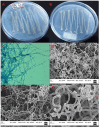Isolation and characterization of Boudabousia marimammalium from a mangrove habitat: identification of dual-function antimicrobial and anticancer peptides
- PMID: 40703228
- PMCID: PMC12285526
- DOI: 10.3389/fmicb.2025.1574859
Isolation and characterization of Boudabousia marimammalium from a mangrove habitat: identification of dual-function antimicrobial and anticancer peptides
Abstract
Actinomycetes were isolated from mangrove soil samples and cultivated on starch casein nitrate (SCN) medium. The isolate was identified as Boudabousia marimammalium through 16S rRNA gene sequencing and phylogenetic analysis using MEGA X. Microscopic examination revealed filamentous mycelia with spirally coiled spore chains bearing cylindrical, hairy spores with curved edges, consistent with the genus morphology. Crude protein was extracted, partially purified (11.52-fold), and quantified (0.195 mg/mL, 8.48% recovery). Antimicrobial activity was tested against a panel of bacterial pathogens, and anticancer potential was evaluated using PC3 prostate cancer cells. LC-MS was employed for compound identification. The crude protein extract exhibited significant antimicrobial activity against Proteus vulgaris (22 ± 0.6 mm), Salmonella typhimurium (15 ± 0.6 mm), Bacillus cereus (13 ± 0.6 mm), Pseudomonas aeruginosa (14 ± 0.6 mm), and Staphylococcus aureus (10 ± 0.6 mm). It also showed anticancer activity, causing 37.43% growth inhibition of PC3 cells at 200 µg. LC-MS analysis identified a dipeptide with a molecular weight of 351.45 Da, corresponding to Tryprostatin B, a known bioactive compound. The isolate B. marimammalium from mangrove soil produces bioactive peptides with dual antimicrobial and anticancer properties.
Keywords: Boudabousia marimammalium; actinomycetes; anticancer peptides; antimicrobial peptides; mangrove habitat.
Copyright © 2025 Karthik, Krishnappa, Ishwara Kalyani, D, H, KM, Thakur, Al-Shuraym, Alkeridis, Aharthy, Alhelaify and Mushtaq.
Conflict of interest statement
The authors declare that the research was conducted in the absence of any commercial or financial relationships that could be construed as a potential conflict of interest.
Figures








References
-
- Abdillah S., Tambunan R. M., Farida Y., Sandhiutami N. M. D., Dewi R. M. (2015). Phytochemical screening and antimalarial activity of some plants traditionally used in Indonesia. Asian Pac. J. Trop. Dis. 5, 454–457. doi: 10.1016/S2222-1808(15)60814-3 - DOI
-
- Aly M. M., Bahamdain L. A., Aba S. A. (2020). Unexplored extreme habitats as sources of novel and rare actinomycetes with enzyme and antimicrobial activities. IOSR J. Pharm. Biol. Sci. 14:10. doi: 10.9790/3008-1406034554 - DOI
LinkOut - more resources
Full Text Sources

